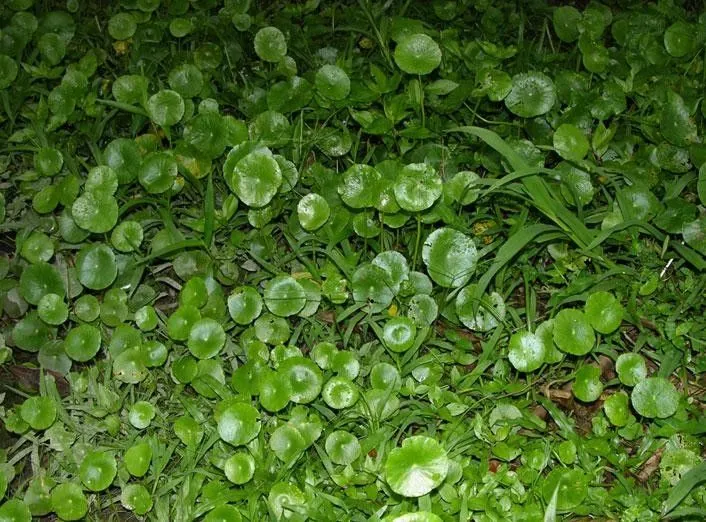
Author: L.
Bibliography: Sp. Pl.: 234 (1753)
Year: 1753
Status: accepted
Rank: species
Genus: Hydrocotyle
Vegetable: False
Observations: America
Water pennywort, known scientifically as Hydrocotyle umbellata, is a captivating aquatic and semi-aquatic plant that finds its origins in the Americas. Documented in 1753 by the eminent botanist Carl Linnaeus, it holds a venerable position within the botanical record.
Characterized by its striking, round, and glossy leaves that resemble small coins, water pennywort naturally thrives along the edges of ponds, lakes, ditches, and slow-moving streams. This unique morphology not only gives the plant its common name but also makes it easily recognizable and distinguishable in its native habitat. Belonging to the Araliaceae family, water pennywort is conspicuous among its relatives for its creeping growth habit and the formation of dense mats on water surfaces and moist grounds.
The plant’s adaptability to both inundated and intermittently dry conditions contributes to its prolific spread and resilience in fluctuating environments. It is often utilized in water gardens and aquaria, where it plays a crucial role in providing cover and promoting ecological balance by offering habitat and shelter to aquatic creatures.
Ecologically, water pennywort is significant in its natural range for helping stabilize soil and prevent erosion along wetland areas. Furthermore, its presence is an indicator of healthy, functioning wetland ecosystems. Traditionally, various cultures in the Americas have utilized Hydrocotyle umbellata for its medicinal properties, taking advantage of its reputed anti-inflammatory and anti-microbial benefits.
Despite its beneficial attributes, it’s worth noting that water pennywort can become invasive in non-native regions, outcompeting local flora and altering aquatic ecosystems. Therefore, responsible cultivation and management are essential to mitigate potential environmental impacts.
In summary, Hydrocotyle umbellata, with its distinct appearance and multifaceted ecological roles, continues to capture interest both botanically and horticulturally. Its rich history and adaptability underscore its importance within the Araliaceae family and its significance within the diverse tapestry of American flora.
Eng: manyflower marshpennywort, water pennywort, many-flowered marsh pennywort, many-flowered water pennywort, marsh pennywort
Fra: hydrocotyle à ombelle
En: Water pennywort, Manyflower marshpennywort, Many-Flower Marsh-Pennywort, UMBRELLA PENNYROYAL, Many-flowered marsh pennywort, Many-flowered water pennywort, Marsh pennywort, Dollarweed
Zh: 伞形天胡荽
Fr: Hydrocotyle à ombelle
Pt: Acariçoba
Pt-br: Acariçoba, Acaricaba, Capitão, Para-sol, Erva-capitão
Th: แว่นแก้ว
Zh-hant: 傘形天胡荽
Taken Apr 17, 2019 by OTS – O. Vargas (cc-by-nc-sa)
Taken Jan 4, 2022 by Maarten Vanhove (cc-by-sa)
Taken May 8, 2022 by Cauich Ahiram (cc-by-sa)
Taken Sep 29, 2020 by Ravinesh Prasad (cc-by-sa)
Taken Jul 21, 2020 by Murat Kucuktepe (cc-by-sa)
Taken Nov 11, 2021 by Dulcinea Dulcinea (cc-by-sa)
Taken Oct 30, 2020 by Xavier Conqueso (cc-by-sa)
Taken Mar 2, 2021 by jivika sachdev (cc-by-sa)
Taken Nov 2, 2020 by Coutinho Ivonete (cc-by-sa)
Taken Apr 17, 2019 by OTS – O. Vargas (cc-by-nc-sa)
Taken Jul 24, 2020 by Sachin Malhotra (cc-by-sa)
Taken Apr 17, 2019 by OTS – O. Vargas (cc-by-nc-sa)
Taken Apr 17, 2019 by OTS – O. Vargas (cc-by-nc-sa)
Taken Apr 17, 2019 by OTS – O. Vargas (cc-by-nc-sa)
© copyright of the Board of Trustees of the Royal Botanic Gardens, Kew.
Growth habit>: Forb/herb
Ph maximum: 6.5
Ph minimum: 5.5
Light: 7
Atmospheric humidity: 8
Bloom months: [‘jun’, ‘jul’, ‘aug’, ‘sep’]
Soil nutriments: 2
Family: Myrtaceae Author: (F.Muell.) K.D.Hill & L.A.S.Johnson Bibliography: Telopea 6: 402 (1995) Year: 1995 Status:…
Family: Rubiaceae Author: Pierre ex A.Froehner Bibliography: Notizbl. Bot. Gart. Berlin-Dahlem 1: 237 (1897) Year:…
Family: Sapindaceae Author: Koidz. Bibliography: J. Coll. Sci. Imp. Univ. Tokyo 32(1): 38 (1911) Year:…
Family: Asteraceae Author: A.Gray Bibliography: Pacif. Railr. Rep.: 107 (1857) Year: 1857 Status: accepted Rank:…
Family: Fabaceae Author: Medik. Bibliography: Vorles. Churpfälz. Phys.-Ökon. Ges. 2: 398 (1787) Year: 1787 Status:…
Family: Aspleniaceae Author: (Cav.) Alston Bibliography: Bull. Misc. Inform. Kew 1932: 309 (1932) Year: 1932…